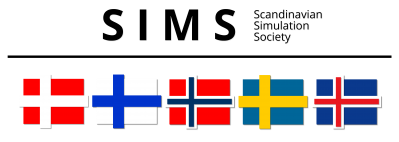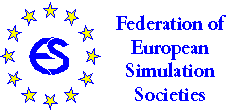 |
9th EUROSIM Congress on Modelling and Simulation, EUROSIM 2016, and 57th SIMS Conference on Simulation and Modelling, SIMS 2016
The 9th EUROSIM Congress on Modelling and Simulation, EUROSIM 2016, and 57th SIMS Conference on Simulation and Modelling, SIMS 2016, were arranged jointly in Oulu, Finland, September 12-16, 2016.
Information
The 9th EUROSIM Congress on Modelling and Simulation, EUROSIM 2016, and 57th SIMS Conference on Simulation and Modelling, SIMS 2016, were arranged jointly in Oulu, Finland, September 12-16, 2016. The Federation of European Simulation Societies (Eurosim) was set up in 1989. The purpose of EUROSIM is to provide a European forum for regional and national simulation societies to promote the advancement of modelling and simulation in industry, research and development. The congress was organized by Scandinavian simulation society (SIMS), Finnish Society of Automation and University of Oulu. SIMS was founded in 1959. The event was co-sponsored by the IFAC Technical Committees on 3.2, 6.1, 6.2, 6.3 and 6.4, the IEEE Computer Society and the IEEE Finland Section. Networking events were organized on three levels: Federation of European Simulation Societies (Eurosim) had Executive Board and Board meetings; Scandinavian simulation society (SIMS) had Board and Annual Meetings and Finnish Simulation Forum (FinSim), founded in 2001, had Board and Annual Meetings.
The overall management was done by the Eurosim Board, consisting of representatives of 17 European Simulation Societies lead by the Eurosim President Dr. Esko Juuso. The NOC was chaired by Prof. Kauko Leiviskä with Co-Chair Dr. Esko Juuso and Vice-Chair Industry Dr. Timo Ahola (FinSim). The IPC Chair Prof. Erik Dahlquist (SIMS), Co-Chair Prof. Bernt Lie (SIMS) and Vice-Chair Industry Dr. Lasse Eriksson were leading the IPC which consisted of 49 scientists. The Publication committee was chaired by Dr. Peter Ylén with C-Chairs Prof. Lars Eriksson and Prof. David Al-Dabass. Eurosim and SIMS Boards were in the IPC. Eurosim members participated actively: 20 Eurosim countries from 14 member societies participated the congress.
The congress had a multi-conference structure with several special topics related to methodologies, functionalities and application areas. The programme includes invited talks, parallel, special and poster sessions, exhibition and versatile technical and social tours. Plenary presentations covered versatile topics: Thermal management within power engineering, Electric arc furnaces, Autonomous driving and traffic maneuvers, Simulation benefits to the mining, mineral and metal industry, Composition of the atmosphere and biophotonic applications.
Majority of sessions focused on industrial topics, including Applied energy, Solar thermal power plants, Energy supply for buildings, Gasification and power plants, Chemical processes, Capture processes, Manufacturing, Mining, Metal and Oil Industry, Water and wastewater systems, Transportation, Mechatronics and Robotics and Bioprocesses. Methodologies covered Computational intelligence, Conceptual modelling, Complex systems, Data analysis, Discrete event systems, Distributed parameter systems, Parallel and distributed interactive systems and Simulation tools and platforms. In the functionalities, the focus on Control, Optimization, Communication, Security, Education and Training, Human-machine interaction, Planning and scheduling, Sensing, Virtual reality and visualization.
Panel discussions were organised for three topics: Modelling and Simulation in Processes and Cleantech, Future energy systems and Intelligent Systems and IoT in Future Automation.
Four technical tours covered steel industry, energy production, radio technology, printed electronics and mining. Tutorials were arranged on simulation tools and platforms.
The congress was very international: there were 181 participants from 33 countries. There were participants from all the continents, except Africa, but there were co-authors also from Africa. The program included 6 plenaries, 175 regular oral and 7 poster presentations. The focus was in Europe: 1/4 from Finland, 1/5 from other Nordic countries and 1/3 from other European countries. Far East was active: 26 participants, where 18 from Japan. In addition, there were 13 participants from other areas (Middle East, Americas and Australia). In total 22% of the participants were from outside Europe, almost as many as from Finland.
Proceedings
Proceedings of Selected Full Papers__ published by Linköping University Press in Linköping Electronic Conference Proceedings No. 142 (ISSN: 1650-3686, eISSN: 1650-3740, ISBN 978-91-7685-399-3),
Proceedings of Short Papers published as a special issue of Simulation Notes Europe (https://www.sne-journal.org/home/).
SNE 28(3), Special Issue "Short Papers 9th EUROSIM Congress, Oulu, 2016", September 2018:
DOI: 10.11128/sne.28.3.1042
ISSN 2306-0271
DOI: 10.11128/sne.28.3.1042
ISSN 2306-0271
Information
The 9th EUROSIM Congress on Modelling and Simulation, EUROSIM 2016, and 57th SIMS Conference on Simulation and Modelling, SIMS 2016, were arranged jointly in Oulu, Finland, September 12-16, 2016. The Federation of European Simulation Societies (Eurosim) was set up in 1989. The purpose of EUROSIM is to provide a European forum for regional and national simulation societies to promote the advancement of modelling and simulation in industry, research and development. The congress was organized by Scandinavian simulation society (SIMS), Finnish Society of Automation and University of Oulu. SIMS was founded in 1959. The event was co-sponsored by the IFAC Technical Committees on 3.2, 6.1, 6.2, 6.3 and 6.4, the IEEE Computer Society and the IEEE Finland Section. Networking events were organized on three levels: Federation of European Simulation Societies (Eurosim) had Executive Board and Board meetings; Scandinavian simulation society (SIMS) had Board and Annual Meetings and Finnish Simulation Forum (FinSim), founded in 2001, had Board and Annual Meetings.
The overall management was done by the Eurosim Board, consisting of representatives of 17 European Simulation Societies lead by the Eurosim President Dr. Esko Juuso. The NOC was chaired by Prof. Kauko Leiviskä with Co-Chair Dr. Esko Juuso and Vice-Chair Industry Dr. Timo Ahola (FinSim). The IPC Chair Prof. Erik Dahlquist (SIMS), Co-Chair Prof. Bernt Lie (SIMS) and Vice-Chair Industry Dr. Lasse Eriksson were leading the IPC which consisted of 49 scientists. The Publication committee was chaired by Dr. Peter Ylén with C-Chairs Prof. Lars Eriksson and Prof. David Al-Dabass. Eurosim and SIMS Boards were in the IPC. Eurosim members participated actively: 20 Eurosim countries from 14 member societies participated the congress.
The congress had a multi-conference structure with several special topics related to methodologies, functionalities and application areas. The programme includes invited talks, parallel, special and poster sessions, exhibition and versatile technical and social tours. Plenary presentations covered versatile topics: Thermal management within power engineering, Electric arc furnaces, Autonomous driving and traffic maneuvers, Simulation benefits to the mining, mineral and metal industry, Composition of the atmosphere and biophotonic applications.
Majority of sessions focused on industrial topics, including Applied energy, Solar thermal power plants, Energy supply for buildings, Gasification and power plants, Chemical processes, Capture processes, Manufacturing, Mining, Metal and Oil Industry, Water and wastewater systems, Transportation, Mechatronics and Robotics and Bioprocesses. Methodologies covered Computational intelligence, Conceptual modelling, Complex systems, Data analysis, Discrete event systems, Distributed parameter systems, Parallel and distributed interactive systems and Simulation tools and platforms. In the functionalities, the focus on Control, Optimization, Communication, Security, Education and Training, Human-machine interaction, Planning and scheduling, Sensing, Virtual reality and visualization.
Panel discussions were organised for three topics: Modelling and Simulation in Processes and Cleantech, Future energy systems and Intelligent Systems and IoT in Future Automation.
Four technical tours covered steel industry, energy production, radio technology, printed electronics and mining. Tutorials were arranged on simulation tools and platforms.
The congress was very international: there were 181 participants from 33 countries. There were participants from all the continents, except Africa, but there were co-authors also from Africa. The program included 6 plenaries, 175 regular oral and 7 poster presentations. The focus was in Europe: 1/4 from Finland, 1/5 from other Nordic countries and 1/3 from other European countries. Far East was active: 26 participants, where 18 from Japan. In addition, there were 13 participants from other areas (Middle East, Americas and Australia). In total 22% of the participants were from outside Europe, almost as many as from Finland.
Proceedings
Proceedings of Selected Full Papers__ published by Linköping University Press in Linköping Electronic Conference Proceedings No. 142 (ISSN: 1650-3686, eISSN: 1650-3740, ISBN 978-91-7685-399-3),
Proceedings of Short Papers published as a special issue of Simulation Notes Europe (https://www.sne-journal.org/home/).
SNE 28(3), Special Issue "Short Papers 9th EUROSIM Congress, Oulu, 2016", September 2018:
DOI: 10.11128/sne.28.3.1042
ISSN 2306-0271
DOI: 10.11128/sne.28.3.1042
ISSN 2306-0271
SIMS, the Scandinavian Simulation Society, is a member of
.
EUROSIM, Federation of European Simulation Societies
http://www.eurosim.info/
